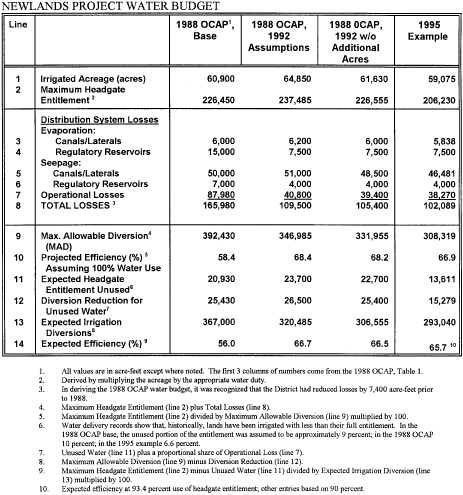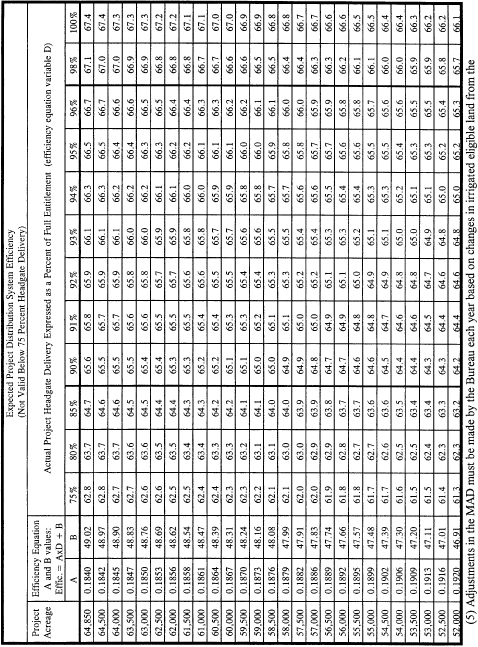Title 43
SECTION 418.13
418.13 Maximum allowable limits.
§ 418.13 Maximum allowable limits.(a) Maximum allowable diversions. (1) A provisional water budget in the Newlands Project Water Budget table must be recalculated for each irrigation season to reflect anticipated water-righted acres to be irrigated. At the start of the irrigation season, the maximum allowable diversion (MAD) for each year must be determined by revising the first 10 lines of the Newlands Project Water Budget table based on acres of eligible land anticipated to actually be irrigated in that year (§ 418.9(a)) and the water duties for those lands (§ 418.10). At the end of the irrigation season, the required target efficiency must be recalculated for the irrigation season based on the actual irrigated acres and percent use of headgate entitlements.

(2) The MAD will be calculated annually to ensure an adequate water supply for all water right holders whose water use complies with their decreed entitlement and this part. The MAD is the maximum amount of water permitted to be diverted for irrigation use on the Project in that year. It is calculated to ensure full entitlements can be provided, but is expected to significantly exceed Project requirements. The MAD will be established by the Bureau at least 2 weeks before the start of each irrigation season. All releases of water from Lahontan Reservoir and diversions from the Truckee Canal (including any diversions from the Truckee Canal to Rock Dam Ditch) must be charged to the MAD except as provided in §§ 418.23 and 418.35 of this part.
(3) On the basis of the methodology adopted in this part (i.e., actual irrigated acres multiplied by appropriate water duties divided by established project efficiency) an example of the MAD calculated for the projected irrigated acreage as shown in the Newlands Project Water Budget table would be 308,319 acre-feet for the 1995 Example. The sample MAD corresponds to a system efficiency for full deliveries at 66.9 percent for 1995 actual acres. Target efficiencies must be based on the percentage of maximum headgate entitlement delivered and not on the percent of water supply available.
(4) The table Expected Project Distribution System Efficiency shows the target efficiencies which will be used over the range of irrigated acreage and percent use of entitlement expected in the future. At the beginning of the irrigation season, the target efficiencies from the Expected Project Distribution System Efficiency table used to calculate the MAD will be based on the expected irrigated acreage and expected percent use of entitlement. At the end of the irrigation season, the actual acreage irrigated and actual percent use of entitlement will be used to determine the required efficiency from the Expected Project Distribution System Efficiency. The target efficiencies are read directly from the table if the acreage and use of entitlement values are shown, otherwise the target efficiency must be extrapolated from the table or calculated using the Efficiency Equation. Appendix A of this part shows the calculations used to derive the Efficiency Equation and the efficiency targets.

(5) Adjustments in the MAD must be made by the Bureau each year based on changes in irrigated eligible land from the prior year and subsequent decisions concerning transfers of Project water rights, using the methodology established in this section.
(6) If the MAD for a given year will not meet the water delivery requirements for the eligible land to be irrigated due to weather conditions, canal breaks, or some other unusual or unforeseen condition, the District must ask the Bureau for additional water.
(i) The District's request must include a written statement containing a detailed explanation of the reasons for the request.
(ii) The Bureau must promptly review the request and after consultation with the Federal Water Master and other interested parties, will determine if the request or any portion of it should be approved. The Bureau will make reasonable adjustments for unforeseen causes or events but will not make adjustments to accommodate waste or Project inefficiency or other uses of water not in accordance with this part or with State and Federal law.
(iii) The Bureau will then notify the District of its determination. If the District does not agree with the Bureau's decision, it may seek judicial review. The Bureau and the District will seek to expedite the court proceeding in order to minimize any potential adverse effects.
(b) Maximum allowable efficiency debits (MED). The debits in Lahontan Reservoir storage from the District's actual conveyance efficiency not achieving the target efficiency can accumulate over time. If these amounts of borrowed storage get too large they may not be offset later by increased efficiencies and may severely affect the District's water users by imposing an added “drought” on top of a real one. Therefore, the maximum efficiency debit cushion is set at 26,000 acre-feet. However, unlike the MAD, it only applies to the subsequent year's operation. The MED is approximately 9 percent of the headgate entitlements.